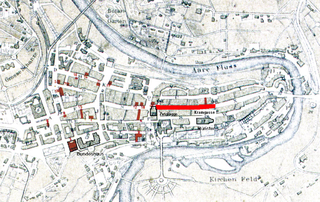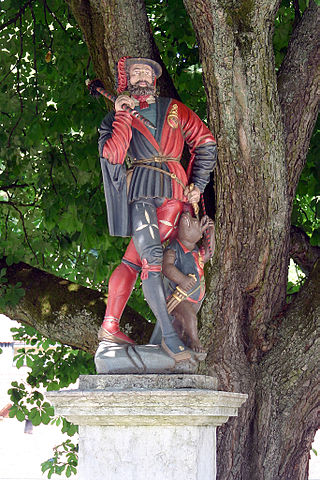
Hans Gieng was a Swiss Renaissance sculptor best known for his public fountain figures in the Old Town of Bern as well as Fribourg.

The Nydeggbrücke is a bridge in Bern, Switzerland which connects the eastern part of the old city to the new part. It crosses over the Aare and is located very close to the Bärengraben. It was built in parallel to the Untertorbrücke in 1840, which until then had been the only bridge crossing the Aare. The Nydeggbrücke is in total 190 meters long and took three years to build. It is a Swiss heritage site of national significance.

The Untertorbrücke is a stone arch bridge that spans the Aare at the easternmost point of the Enge peninsula in the city of Bern, Switzerland, connecting the Mattequartier in the Old City to the Schosshalde neighbourhood. Built in its current form in 1461–89, it is the oldest of Bern's Aare bridges, and was the city's only bridge up until the middle of the 19th century. It is a Swiss heritage site of national significance.

Schänis Abbey was founded in the 9th century. It was situated in the present town of Schänis in the canton of St. Gallen, Switzerland. It was a house of secular canonesses of the nobility and was dissolved in 1811.

The Old City is the medieval city center of Bern, Switzerland. Built on a narrow hill bordered on three sides by the river Aare, its compact layout has remained essentially unchanged since its construction during the twelfth to the fifteenth century. Despite a major fire in 1405, after which much of the city was rebuilt in sandstone, and substantial construction efforts in the eighteenth century, Bern's old city has retained its medieval character.

The Kindlifresserbrunnen is a painted stone fountain at the Kornhausplatz in Bern, Switzerland. It is one of the Old City of Bern's fountains from the 16th century.

The Kramgasse is one of the principal streets in the Old City of Bern, the medieval city centre of Bern, Switzerland. It was the center of urban life in Bern until the 19th century. Today, it is a popular shopping street. Its length, slight curve and long line of Baroque façades combine to produce Bern's most impressive streetscape.

The Gerechtigkeitsgasse is one of the principal streets in the Old City of Bern, the medieval city center of Bern, Switzerland. Together with its extension, the Kramgasse, it is the heart of the inner city. Hans Gieng's most famous fountain figure, the statue of Lady Justice on the Gerechtigkeitsbrunnen, commands the view of the street's gentle slopes and curves.

The Gerechtigkeitsbrunnen is a 16th-century fountain in the Gerechtigkeitsgasse in the Old City of Bern, Switzerland. It is the only Bernese fountain to retain all original design elements, and is listed as a cultural heritage of national significance.

The Junkerngasse is a street in the Old City of Bern, the medieval city center of Bern, Switzerland. It connects the tip of the Aar peninsula to the Münster.

Gottstat Monastery is a former Premonstratensian monastery in the municipality of Orpund in the Canton of Bern, Switzerland.

The Spitalgasse is one of the streets in the Old City of Bern, the medieval city center of Bern, Switzerland. It is part of the Äussere Neustadt which was built during the third expansion from 1344 to 1346. The eastern end is at Waisenhausplatz and Bärenplatz while the western end is at Bahnhofplatz near the Church of the Holy Ghost. It is part of the UNESCO Cultural World Heritage Site that encompasses the Old City.

The Bahnhofplatz is a plaza just outside the Old City of Bern, the medieval city center of Bern, Switzerland. It was built following the destruction of the Christoffelturm which had been part of the third city wall. It is located north of Bubenbergplatz and surrounds the Heiliggeistkirche and Bern's central train station. It is part of the UNESCO Cultural World Heritage Site that encompasses the Old City.

The Reformed Nydeggkirche is located on the eastern edge of the Old City of Bern, in the Nydegg section.

The Läuferbrunnen is a fountain on Läuferplatz in the Old City of Bern, Switzerland. It is a Swiss Cultural Property of National Significance and is part of the UNESCO World Heritage Site of the Old City of Bern.
The Zähringerbrunnen is a fountain on Kramgasse in the Old City of Bern, Switzerland. It is a Swiss Cultural Property of National Significance and is part of the UNESCO World Heritage Site of the Old City of Bern.

Baden railway station serves the municipality of Baden, in the canton of Aargau, Switzerland. Opened in 1847, it is owned and operated by SBB-CFF-FFS.

The Bern Town Hall is the building in Bern, Switzerland that houses the Grand Council of Bern, the Executive Council of Bern and the Grand Council of the City of Bern. The building is part of the UNESCO World Heritage Site of the Old City of Berne and is a Swiss heritage site of national significance.






















